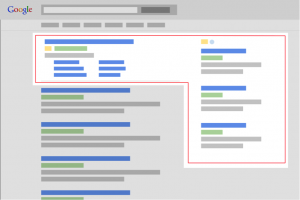What Google Changed and Why
Google typically makes fun, quirky changes to their logo and algorithms, but rarely do they change the way in which their search engine results pages (SERP) appear. Recently, Google decided to remove right-side paid ads (AdWords) on desktop searches.
How has the paid ads display changed?
Before, paid ads were located at the top of, along the right-side, and at the bottom of the search engine results page.

Now, Google has completely removed ads on the right-side and expanded top-page paid ad results from three to four positions:

What is the impact of these changes?
There are at least two major impacts of this change:
- Cleaner User Experience: By including fewer options, it’s easier to view paid ads using a desktop computer or full-size laptop. It also provides a more unified experience between mobile and desktop search. In recent years, Google has made strides to create a better search experience on mobile devices. One example of this is Google’s recent decision to make mobile friendliness a ranking factor. By eliminating side ads and expanding positions on top-page paid ads, Google is getting rid of clutter that wouldn’t appear on mobile devices anyway.
- More Relevant Clicks for Businesses: Searchers are more likely to click on top-page ads than right-side ads because sometimes the top-page paid ads appear to be part of the organic (non-paid) search results. And, having less competition on the page can help you get more relevant clicks, resulting in more visitors to your practice’s website.
What This Means for Your Practice’s Dental Marketing Strategy
Though it’s hard to predict the overall impact to your practice (it will vary depending on how you use online marketing today), it’s safe to say the way consumers interact with ads in a search will change. For example, while fewer ads could increase organic traffic, a fourth ad above organic results could also push these results down the page which lowers the value of organic search. However, no ads on the right-side of the page, means fewer non-clicked ads.
In the short term, if your online marketing strategy includes search engine optimization (SEO), this should have little to no impact. If you are utilizing pay-per-click (PPC), you could potentially have less competition on the page, which means more focused search results. In the long term, having a consolidated approach that involves both SEO and PPC will provide the most positive impact.
If you have hired ProSites to manage your practice’s SEO and/or PPC strategy, we are already aware of this update and watching for significant changes to your website traffic performance. If we see any negative changes, we will update your strategy accordingly.
How This Affects PPC
With removal of the right-side ad space, your PPC ads will likely compete for even less ad real-estate “above the fold.” A change in key metrics may indicate that you’ve been affected by this new update.
Here’s some tips that you can follow to keep tabs on any impact:
- Review how your ads are appearing in Google’s search results page by navigating to the Tools tab and then clicking on “Ad Preview and Diagnosis”.
- Review your average position in search results for a given keyword. Having an average position above three or four will help you maintain higher impressions and clicks on your ads. You can find the “Average Position” metric in the Keywords tab of AdWords. If you’re a ProSites PPC client, this information is included in your monthly report.
- Increase your position in search results for relevant keywords. You can do this in two ways: improve your quality score and/or increase your bid. Note: Check your cost per acquisition (CPA) to ensure you are not bidding too high.
How This Affects SEO
Because top-page ads are now pushing organic results further down the page, strong SEO plays a larger part in getting your practice as close to the top of page 1 results as possible.
In many cases, when someone searches for a local service, Google will include a handful of local business listings with a map noting their locations. These listings, known as the snack pack, appear immediately under paid ads. So, if the snack pack is displayed, organic results are pushed even further down page 1.
As you can see from the example below, organic search results do appear, but not until four paid results and three snack pack results are displayed. Therefore, the first organic result is actually in the eighth position on the page.

Tying it all together
Google never makes any changes without a wealth of data and due-diligence, so it’s our guess that this new update is here to stay. As a dentist, it’s important to remain informed about these updates and their potential impact to your online marketing strategy. Or, if that feels like a lot of work, hire a professional who will stay informed and make appropriate shifts to your online marketing strategy to keep you ahead of the competition.








